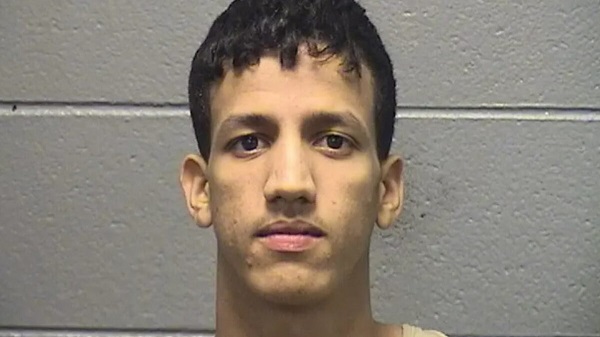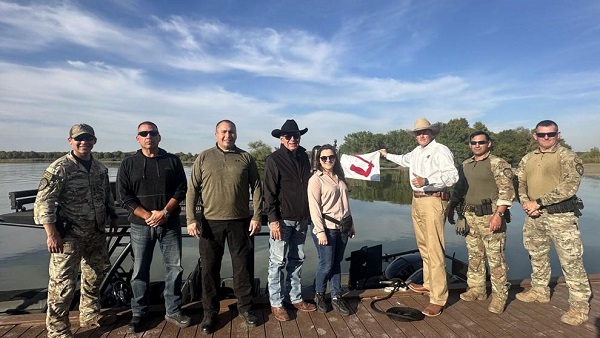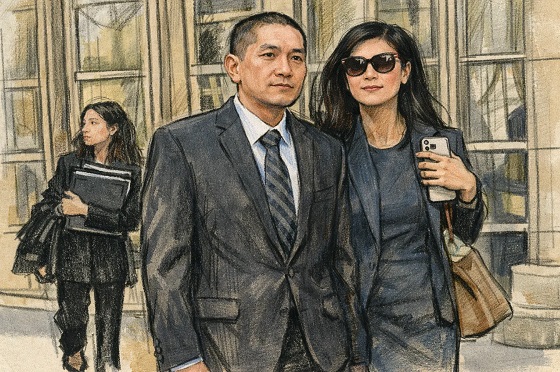illegal immigration
Without A Reckoning, The First U.S. Terror Attack Caused By Open Borders Won’t Be The Last

From Todd Bensman from the Center for Immigration Studies as posted in The Federalist
Americans deserve a full-scale investigation into what happened in Chicago and how to prevent the next open-borders-enabled attack on U.S. soil.
Surprisingly little news coverage followed America’s first terror attack by an illegal border-crossing immigrant on U.S. soil. On Saturday, 22-year-old Mauritanian Sidi Mohamed Abdallahi was found dead of an apparent hanging suicide in his Cook County, Illinois jail cell. America must learn from this to prevent the next attacks on U.S. soil by border-infiltrating jihadists.
Abdallahi illegally jumped the border from Tijuana to San Diego in March 2023 and was freed by U.S. Border Patrol. Under orders from the Biden-Harris Department of Homeland Security, Border Patrol has released millions of illegal entrants into the United States in the last four years.
On October 26, Abdallahi allegedly hunted down and shot in the back an identifiably Orthodox Jewish man walking to synagogue, then tried to up the body count by attacking responding police while shouting “Allahu Akbar!” Abdallahi still didn’t quit shooting even after police wounded him. Somehow he, the police, and the victim all survived.
This benchmarking story of America’s first terror attack by a border-crossing jihadist was largely ignored by national news media even though it came just before the brewing political war between pro-illegal immigrant Democrats and an incoming Trump administration promising an illegal immigration crackdown largely on national security grounds.
Now there will not even be a trial. Abdallahi’s sudden exit is no doubt privately regarded as a gift to pro-open borders advocates, their media sympathizers, and Democrat elected officials. But independent media and elected government must press for further details to prevent the next border-crossing terrorist attack.
What We Know So Far
At a late November arraignment reported on by a Chicago Fox News affiliate and the Chicago Sun-Times, prosecutors revealed that, while working at an Amazon warehouse, Abdallahi carefully planned his attack on Jewish targets due to jihadist ideology.
“This was not anything but a planned attack…an attempted assassination of these people,” Assistant State’s Attorney Anne McCord Rodgers told the court. “This was a calculated plan, on a public street…and attempted slaughter of that person and law enforcement officers.”
Abdallahi had mapped out the locations of two Chicago synagogues and a Jewish community, the conservative Chicago Sun-Times reported November 21. The search history also included “Jewish Community Center” and a gun store in suburban Lyons.
Once he shot the man in the back, Abdallahi displayed a relentless desire to increase his body count and seemed tactically aware of how to take out hard human targets like police officers. For example, his gun apparently jammed after shooting the Jewish victim, prosecutors said. He reportedly had the presence of mind to retreat to cover, fix the jam, then return to finish off the victim, but then retreated to cover again as first responders approached.
Abdallahi drove a few blocks around them, then returned on foot from a new direction and opened fire on four police officers and two paramedics tending the wounded man, prosecutors alleged. He then allegedly fired on the ambulance, hitting it twice as a fifth police officer returned fire.
Wounded, finally, Abdallahi fell. But he rose repeatedly to allegedly fire on the police even more before finally collapsing. Miraculously, none of his intended victims were hit.
This Case Has National Implications
The untold full story of Abdallahi’s illegal border crossing and attack in Chicago the next year, of course, goes beyond the evidence so far showing Abdallahi followed a violent ideology. Americans can no longer regard the possibility of Islamic terrorist infiltration from the southern border as merely a hypothetical bogeyman. Because of Chicago, no longer can the warnings of homeland security professionals like those quoted in my America’s Covert Border War book be dismissed as anti-immigrant fearmongering.
This terror attack and police gunbattle with an alleged border-crossing jihadist instead firmly justifies bipartisan public inquiry, public and private investigation, and analysis about border security policy that can stop future Abdallahis. After September 11, 2001, America justifiably worried about fixing the broken U.S. visa systems that 9/11 hijackers easily defrauded to enter the United States for that larger attack.
So far, the institutional media and government powers-that-be have managed to box up the Chicago incident as a mere local affair. It’s not even charged as a federal terrorism case.
Under pressure from Chicago’s Jewish community for Chicago officials to publicly acknowledge that a local Jewish man was violently attacked based on his religion, Cook County’s far-left, George Soros-backed State’s Attorney Kim Foxx (who leaves office next year) eventually charged Abdallahi with terrorism, under Illinois’ circa-9/11 terrorism statute.
This case demands intense national attention. Chicago’s attack is an uncontestable confirmation of the terrorism threat inherent in open borders policies. President Donald Trump promised throughout his campaign to reverse Democrats’ open border, catch-and-release policies. Yet open-borders advocates are organizing to wage political, information, and legal warfare to defeat Trump’s enforcement of U.S. immigration laws. Front-and-center attention on the Chicago terrorist attack would provide Americans the context they deserve during the melee over Trump’s planned illegal immigration fixes.
If the Chicago terror attack is allowed to fade away after Abdallahi’s burial, Americans will have been robbed of their ability to loudly petition for protection from the next such terror attack. The next attack could easily target the towns now vowing to “Trump-proof” themselves against policies that would deport other Abdallahis before they also can attack.
Questions Americans Deserve Answered
Failing to investigate this incident will likely leave the doors open to more such attacks. So far, there’s been no public sign of FBI or Department of Justice involvement in the Chicago case, as would be ordinary when Islamic terrorism is indicated in any attack on U.S. soil.
Ceding this case entirely to state and local authorities with less counterterrorism training and intelligence resources leaves too much on the table. For example: are co-conspirators or sympathizers who urged Abdallahi on still out there? Did foreign terrorism masters direct Abdallahi? Chicago police may be well-meaning and reasonably resourced, but counterterrorism is the FBI’s unique province.
If the bureau is not involved, why not? If it is, good, but to what extent did the FBI follow leads and intelligence and provide the results to Chicago PD (which may not hold the security clearances to ingest such information)? Might Chicago, a sanctuary city, even have refused to collaborate with the FBI for partisan reasons during a hotly contested presidential campaign?
Abdallahi reportedly did not flag on any terrorism or criminal databases when Border Patrol detained him in San Diego Sector. Was he ever detained and referred to the Border Patrol’s Tactical Terrorism Response Team or Immigration and Customs Enforcement intelligence officers for extended terrorism-related interviews? That is supposed to happen with “special interest aliens,” who get assigned that tag if they hail from designated countries of terrorism concern like Mauritania.
According to material obtained by the Center for Immigration Studies through a Freedom of Information Act request, Border Patrol apprehended 18,260 Mauritanians illegally crossing the U.S. southern border from 2021 through December 2023. ISIS, al-Qaeda, al-Mourabitoun, and other violent Islamist groups operate throughout the Sahel region of northwest Africa, which includes Mauritania, according to many credible sources about international terrorism.
Face-to-face interviews with Mauritanians and all other special interest aliens can be the difference between deporting a dangerous terrorist or letting one into the country. Have those happened with those 18,260 Mauritanians admitted to the U.S. in just three years? Will they?
Abdallahi is dead. But his case presents a rare opportunity for the traditional bastions of government accountability to get interested and get to work with this last question in mind: Is a Jewish Chicagoan the first American to be shot by a border-crossing jihadi, or the last?
illegal immigration
US Notes 2.5 million illegals out and counting

President Trump’s Department of Homeland Security is marking what officials are calling a landmark moment in U.S. immigration enforcement, announcing Wednesday that more than 2.5 million illegal aliens have now left the country since Trump returned to the Oval Office in January. DHS Secretary Kristi Noem said the surge reflects a sweeping, sustained crackdown driven by Immigration and Customs Enforcement teams that — according to internal tallies — have already removed more than 605,000 illegal aliens, most of whom were facing criminal charges or carrying prior convictions. Nearly two million more have opted to self-deport, a wave Noem attributes to stepped-up enforcement and the administration’s aggressive public messaging. She again urged those still in the country illegally to use the government’s CBP Home app, which offers a free one-way flight and a $1,000 stipend to expedite departure.
Senior DHS officials say arrests have climbed as well, with almost 600,000 illegal aliens taken into custody since January 20. “Illegal aliens are hearing our message to leave now,” DHS official McLaughlin said this week. “They know if they don’t, we will find them, we will arrest them, and they will never return.”
The administration argues the impact is being felt far beyond immigration courts and detention facilities, pointing to the U.S. housing market as one of the clearest signs of change. For six straight months, DHS says not a single illegal alien has been released into the interior from the southern border — a dramatic shift after years of mass inflows under President Biden. That decline, they say, is finally filtering into rent and home-price data after years of punishing increases.
Housing and Urban Development Secretary Scott Turner said Americans have now seen four consecutive months of rent decreases — the first sustained drop in years — as fewer illegal aliens compete for housing. Vice President JD Vance emphasized the connection even more bluntly: “The connection between illegal immigration and skyrocketing housing costs is as clear as day. We are proud to be moving in the right direction. Still so much to do.”
Research abroad and at home backs up the administration’s argument. Economists in Denmark released findings earlier this year showing that a one-percentage-point rise in local immigration over a five-year period drove private rental prices up roughly 6 percent and home prices up about 11 percent. The Center for Immigration Studies presented similar data to Congress last year, with researcher Steven Camarota testifying that a 5-percentage-point increase in a metro area’s recent-immigrant share was tied to a 12-percent rise in rent for U.S.-born households.
As DHS leaders frame it, Trump’s second-term enforcement machine is reshaping both border policy and household budgets — an approach they say is finally delivering relief to Americans who spent years squeezed by soaring housing costs and unchecked migration.
illegal immigration
EXCLUSIVE: Canadian groups, First Nation police support stronger border security

First Nation police chiefs join Texas Department of Public Safety marine units to patrol the Rio Grande River in Hidalgo County, Texas. L-R: Dwayne Zacharie, President of the First Nations Chiefs of Police Association, Ranatiiostha Swamp, Chief of Police of the Akwesasne Mohawk Territory, Brooks County Sheriff Benny Martinez, Jamie Tronnes, Center for North American Prosperity and Security, Goliad County Sheriff Roy Boyd. Photo: Bethany Blankley for The Center Square
From The Center Square
By
Despite Canadian officials arguing that the “Canada-U.S. border is the best-managed and most secure border in the world,” some Canadian groups and First Nation tribal police chiefs disagree.
This week, First Nation representatives traveled to Texas for the first time in U.S.-Canadian history to find ways to implement stronger border security measures at the U.S.-Canada border, including joining an Operation Lone Start Task Force, The Center Square exclusively reported.
Part of the problem is getting law enforcement, elected officials and the general public to understand the reality that Mexican cartels and transnational criminal organizations are operating in Canada; another stems from Trudeau administration visa policies, they argue.
When it comes to public perception, “If you tell Canadians we have a cartel problem, they’ll laugh at you. They don’t believe it. If you tell them we have a gang problem, they will absolutely agree with you 100%. They don’t think that gangs and cartels are the same thing. They don’t see the Hells Angels as equal to the Sinaloa Cartel because” the biker gang is visible, wearing vests out on the streets and cartel operatives aren’t, Jamie Tronnes, executive director of the Center of North American Prosperity and Security, told The Center Square in an exclusive interview.
The center is a US-based project of the MacDonald-Laurier Institute, the largest think tank in Canada. Tronnes previously served as a special assistant to the cabinet minister responsible for immigration and has a background in counterterrorism. She joined First Nation police chiefs to meet with Texas law enforcement and officials this week.
Another Canadian group, Future Borders Coalition, argues, “Canada has become a critical hub for transnational organized crime, with networks operating through its ports, banks, and border communities.” The Sinaloa and Jalisco New Generation Mexican cartels control the fentanyl, methamphetamine and cocaine business in Canada, partnering with local gangs like the Hells Angels and Chinese Communist Party (CCP)-linked actors, who launder profits through casinos, real estate, and shell companies in Vancouver and Toronto, Ammon Blair, a senior fellow at the Texas Public Policy Foundation, and others said at a coalition event prior to First Nation police chiefs and Tronnes coming to Texas.
“The ’Ndrangheta (Italian Mafia) maintains powerful laundering and import operations in Ontario and Quebec, while MS-13 and similar Central American gangs facilitate human smuggling and enforcement. Financial networks tied to Hezbollah and other Middle Eastern groups support laundering and logistics for these criminal alliances,” the coalition reports.
“Together, they form interconnected, technology-driven enterprises that exploit global shipping, cryptocurrency, and AI-enabled communications to traffic whatever yields profit – narcotics, weapons, tobacco, or people. Taking advantage of Canada’s lenient disclosure laws, fragmented jurisdictions, and weak cross-border coordination, these groups have embedded themselves within legitimate sectors, turning Canada into both a transit corridor and safe haven for organized crime,” the coalition reports.
Some First Nation reservations impacted by transnational crime straddle the U.S.-Canada border. One is the Akwesasne Mohawk Reservation, located in Ontario, Quebec, and in two upstate New York counties, where human smuggling and transnational crime is occurring, The Center Square reported. Another is the Tsawwassen First Nation (TWA) Reservation, located in a coastal region south of Vancouver in British Columbia stretching to Point Roberts in Washington state, which operates a ferry along a major smuggling corridor.
Some First Nation reservations like the TWA are suffering from CCP organized crime, Tronnes said. Coastal residents observe smugglers crossing their back yards, going through the reserve; along Canada’s western border, “a lot of fentanyl is being sent out to Asia but it’s also being made in Canada,” Tronnes said.
Transnational criminal activity went largely unchecked under the Trudeau government, during which “border security, national security and national defense were not primary concerns,” Tronnes told The Center Square. “It’s not to say they weren’t concerns, but they weren’t top of mind concerns. The Trudeau government preferred to focus on things like climate change, international human rights issues, a feminist foreign policy type of situation where they were looking more at virtue signaling rather than securing the country.”
Under the Trudeau administration, the greatest number of illegal border crossers, including Canadians, and the greatest number of known, suspected terrorists (KSTs) were reported at the U.S.-Canada border in U.S. history, The Center Square first reported. They include an Iranian with terrorist ties living in Canada and a Canadian woman who tried to poison President Donald Trump, The Center Square reported.
“Had it been a priority for the government to really crack down and provide resources for national security,” federal, provincial and First Nation law enforcement would be better equipped, funded and staffed, Tronnes said. “They would have better ways to understand what’s really happening at the border.”
In February, President Donald Trump for the first time in U.S. history declared a national emergency at the northern border and ordered U.S. military intervention. Months later, his administration acknowledged the majority of fentanyl and KSTs were coming from Canada, The Center Square reported.
Under a new government and in response to pressure from Trump, Canada proposed a $1.3 billion border plan. However, more is needed, the groups argue, including modernizing border technology and an analytics infrastructure, reforming disclosure and privacy rules to enable intelligence sharing, and recognizing and fully funding First Nation police, designating them as essential services and essential to border security.
“National security doesn’t exist without First Nation policing at the border,” Dwayne Zacharie, First Nations Chiefs of Police president, told The Center Square.
-

 Business2 days ago
Business2 days agoDeadlocked Jury Zeroes In on Alleged US$40 Million PPE Fraud in Linda Sun PRC Influence Case
-

 International2 days ago
International2 days agoOttawa is still dodging the China interference threat
-

 Business15 hours ago
Business15 hours agoThere’s No Bias at CBC News, You Say? Well, OK…
-

 espionage2 days ago
espionage2 days agoCarney Floor Crossing Raises Counterintelligence Questions aimed at China, Former Senior Mountie Argues
-

 Business1 day ago
Business1 day agoTaxing food is like slapping a surcharge on hunger. It needs to end
-

 COVID-192 days ago
COVID-192 days agoJudge denies Canadian gov’t request to take away Freedom Convoy leader’s truck
-

 Energy2 days ago
Energy2 days ago75 per cent of Canadians support the construction of new pipelines to the East Coast and British Columbia
-

 Health1 day ago
Health1 day agoFDA warns ‘breast binder’ manufacturers to stop marketing to gender-confused girls









